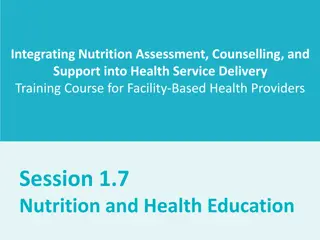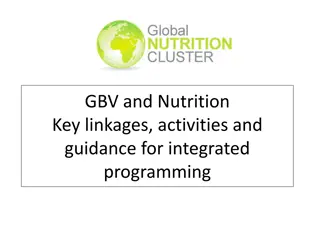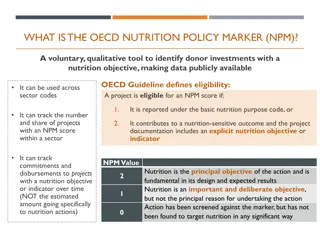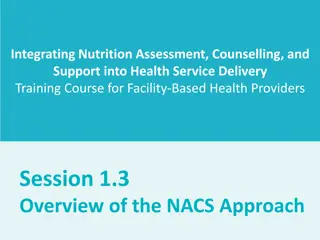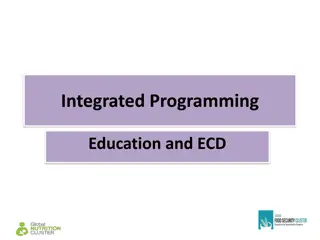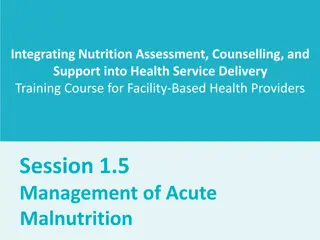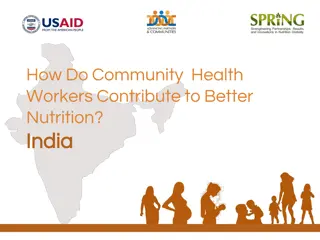Integrating Nutrition Assessment and Counseling for Health Providers
This training session introduces the importance of nutrition for health by defining key terms, explaining essential nutrients, and identifying food sources. Participants will learn about macronutrients, micronutrients, energy balance, and the role of a balanced diet. The session aims to equip facility-based health providers with knowledge to integrate nutrition assessment, counseling, and support into their service delivery effectively.
Download Presentation

Please find below an Image/Link to download the presentation.
The content on the website is provided AS IS for your information and personal use only. It may not be sold, licensed, or shared on other websites without obtaining consent from the author. Download presentation by click this link. If you encounter any issues during the download, it is possible that the publisher has removed the file from their server.
E N D
Presentation Transcript
Integrating Nutrition Assessment, Counselling, and Support into Health Service Delivery Training Course for Facility-Based Health Providers Session 1.1 Introduction to Nutrition
Session Objectives By the end of the session, participants should be able to: Define common nutrition terms Explain the importance of adequate nutrition for health Describe essential nutrients needed by the body and their roles Identify food sources of specific nutrients Integrating Nutrition Assessment, Counselling, and Support into Health Service Delivery 2
Key Nutrition-Related Terms Brainstorm: What do these terms mean to you? Nutrition Food Nutrients oMacronutrients oMicronutrients Energy Balanced/nutritious diet Integrating Nutrition Assessment, Counselling, and Support into Health Service Delivery 3
Key Nutrition-Related Terms Nutrition is a process by which food and drink is taken, digested, absorbed, and used by the body for physical activity, growth, development, and health. Food is any substance (solid, semi-solid, or liquid) taken into the body to provide one or more nutrients. Integrating Nutrition Assessment, Counselling, and Support into Health Service Delivery 4
Key Nutrition-Related Terms Nutrients are nourishing substances needed by the body for physical activity, growth, development, and health. They include: o Macronutrients: needed in large quantities and provide energy. Carbohydrates, fats, and proteins are macronutrients. o Micronutrients: needed by the body in very small amounts. Vitamins and minerals are micronutrients. Integrating Nutrition Assessment, Counselling, and Support into Health Service Delivery 5
Key Nutrition-Related Terms Energy, measured in kilocalories (kcal), is required for all functions of the body. The body gets energy through consumption of macronutrients. A balanced or nutritious diet is a combination of foods that provides the energy and nutrients the body needs in the right amounts to maintain health, growth, and development. Integrating Nutrition Assessment, Counselling, and Support into Health Service Delivery 6
Brainstorm Why is nutrition important for health? What could happen to someone who has poor nutrition? Integrating Nutrition Assessment, Counselling, and Support into Health Service Delivery 7
Essential Nutrients Micronutrients Vitamins Minerals Macronutrients Carbohydrates Fats Proteins Water Integrating Nutrition Assessment, Counselling, and Support into Health Service Delivery 8
Essential Nutrients Carbohydrates Starches, fibre, and sugars Found in grains/cereals, roots, starchy fruits and vegetables Main source of energy Fuel physical activity and basic body functions Fats (lipids) Found in vegetable oils and animal fats (e.g., butter, lard, ghee) Build body cells, provide energy to fuel muscles, help body to absorb fat-soluble vitamins Support brain development of infants and children Include saturated fats and trans fats (solid at room temperature) and unsaturated fats (liquid at room temperature) Integrating Nutrition Assessment, Counselling, and Support into Health Service Delivery 9
Essential Nutrients Proteins Body-building foods that are required for growth and development Found in eggs, meat, poultry, fish, beans, lentils, nuts Needed for maintenance and repair of tissues, production of metabolic and digestive enzymes, and formation of certain hormones and all cells and tissues Integrating Nutrition Assessment, Counselling, and Support into Health Service Delivery 10
Essential Nutrients Vitamins Organic compounds that perform specific metabolic functions in the body Fat-soluble vitamins (vitamins A, D, E, and K) Stored by the body Support development and maintenance of body tissues and their functions. For example: Vitamin A for the eyes Vitamin D for the bones Vitamin K for blood clotting Vitamin E for protection of cells Integrating Nutrition Assessment, Counselling, and Support into Health Service Delivery 11
Essential Nutrients Water-soluble vitamins Not stored in the body and are entirely derived from daily diet Include B-group and C vitamins Support utilization of macronutrients Synthesize red blood cells Integrating Nutrition Assessment, Counselling, and Support into Health Service Delivery 12
Essential Nutrients Minerals Inorganic compounds that are necessary for normal body functioning. Some key minerals include: Iron, whichhelps transfer of oxygen to various tissues Calcium, a key component of bones and teeth Iodine, which supports thyroid function and mental development in children Zinc, which enhances and strengthens the immune system and helps in wound healing . Integrating Nutrition Assessment, Counselling, and Support into Health Service Delivery 13
Essential Nutrients Water An essential nutrient necessary for body functions including digestion, absorption, and certain metabolic processes. Drinking water should be boiled or treated. Integrating Nutrition Assessment, Counselling, and Support into Health Service Delivery 14
Food Groups Foods can be categorized into three main groups: Go foods (energy foods) Grow foods (body-building foods) Glow foods (body-protecting foods) Integrating Nutrition Assessment, Counselling, and Support into Health Service Delivery 15
Food Groups Go Foods: Provide energy CARBOHYDRATES Whole grains Refined grains Roots Starchy fruits and vegetables Matooke Gonja (plantains) Squash Pumpkin Millet flour Sorghum flour Whole wheat flour (brown) Whole maize meal (brown) Brown rice Whole wheat bread Corn flakes White wheat flour White maize meal White rice White bread Cassava Irish potatoes Sweet potatoes Yams Integrating Nutrition Assessment, Counselling, and Support into Health Service Delivery 16
Go Foods (continued) OILS (LIQUIDS) UNSATURATED FATS (SOLIDS) SATURATED AND TRANS Plant source: Sunflower, soybean, corn/maize, cottonseed, canola, sesame, groundnut, olive, safflower, and walnut oils Animal source: Milk fat (ghee), butter, beef fat, chicken fat, pork fat (lard) Plant source: Margarine, kimbo, cowboy, coconut, palm oil Excessive consumption of saturated and trans fats increases risk of heart disease. Replacing with unsaturated fats may reduce risk of heart disease. Integrating Nutrition Assessment, Counselling, and Support into Health Service Delivery 17
Grow Foods Rich in body-building proteins ANIMAL SOURCE Meats: Beef, lamb, pork, veal, game meat (rabbit, guinea fowl, squirrel) PLANT SOURCE Beans and peas: Black beans, soy beans, black-eyed peas, kidney beans, white beans Organ meats: Liver, giblets Processed soy products: Curd made from soy Poultry: Chicken, duck, goose, turkey, eggs Nuts and seeds: Peanuts, pumpkin seeds, sunflower seeds, cashews, peanut butter Fish: Silver fish, Nile perch, tilapia, mudfish, oysters, canned fish Dairy products: Milk, cheese, yoghurt, whey Edible insects: Grasshoppers, termites, white ants, crickets, caterpillars Integrating Nutrition Assessment, Counselling, and Support into Health Service Delivery 18
Glow Foods Rich in protective vitamins and minerals FRUITS Commonly eaten fruits: Bananas, pineapples, papaya (pawpaw), mangoes, guavas, oranges, Jack fruits, tangerines, apples, brother hearts Wild fruits: Tamarinds, berries, wild grapefruits Fruit juice: Passion, orange, apple, pineapple, melon, grape, grapefruit, hibiscus Integrating Nutrition Assessment, Counselling, and Support into Health Service Delivery 19
Glow Foods VEGETABLES Dark green leafy vegetables: Spinach, Dodo/amarantha, sukuma wiki, cowpea leaves, pumpkin leaves, cassava leaves, fresh cowpea leaves, field pea leaves, immature corn, green pea leaves, yam leaves, sweet potato leaves, broccoli, lettuce, hibiscus leaves (Malakwang) Red and orange vegetables: Carrots, pumpkin, red peppers, sweet potatoes, tomatoes, tomato juice, red amarantha, red hibiscus Other vegetables: Avocado, beet roots, cabbage, eggplant, cucumbers, cauliflower, green beans, green peppers, mushrooms, okra, onions, bean sprouts, celery Wild vegetable: Wild cucumber Iodized salt is an important glow food. Meat, poultry, fish, and whole grains are also important sources of some vitamins and minerals. Integrating Nutrition Assessment, Counselling, and Support into Health Service Delivery 20
Thank you! Questions, additions, and clarifications? Thank you! Questions, additions, and clarifications? Integrating Nutrition Assessment, Counselling, and Support into Health Service Delivery 21






